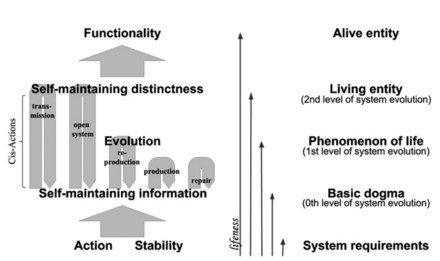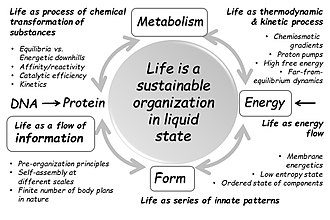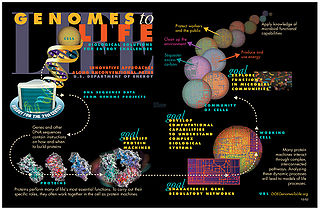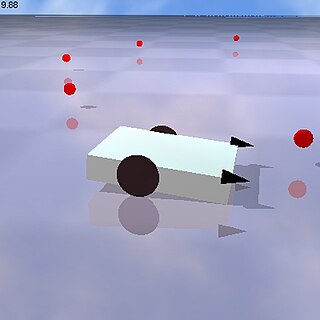Theories
Miller's open systems
James Grier Miller's living systems theory is a general theory about the existence of all living systems, their structure, interaction, behavior and development, intended to formalize the concept of life. According to Miller's 1978 book Living Systems, such a system must contain each of twenty "critical subsystems" defined by their functions. Miller considers living systems as a type of system. Below the level of living systems, he defines space and time, matter and energy, information and entropy, levels of organization, and physical and conceptual factors, and above living systems ecological, planetary and solar systems, galaxies, etc. [3] [4] [5] Miller's central thesis is that the multiple levels of living systems (cells, organs, organisms, groups, organizations, societies, supranational systems) are open systems composed of critical and mutually-dependent subsystems that process inputs, throughputs, and outputs of energy and information. [6] [7] [8] Seppänen (1998) says that Miller applied general systems theory on a broad scale to describe all aspects of living systems. [9] Bailey states that Miller's theory is perhaps the "most integrative" social systems theory, [10] clearly distinguishing between matter–energy-processing and information-processing, showing how social systems are linked to biological systems. LST analyzes the irregularities or "organizational pathologies" of systems functioning (e.g., system stress and strain, feedback irregularities, information–input overload). It explicates the role of entropy in social research while it equates negentropy with information and order. It emphasizes both structure and process, as well as their interrelations. [11]
Lovelock's Gaia hypothesis
The idea that Earth is alive is found in philosophy and religion, but the first scientific discussion of it was by the Scottish geologist James Hutton. In 1785, he stated that Earth was a superorganism and that its proper study should be physiology. [12] : 10 The Gaia hypothesis, proposed in the 1960s by James Lovelock, suggests that life on Earth functions as a single organism that defines and maintains environmental conditions necessary for its survival. [13] [14]
Piast's self-maintainable information

All living entities possess genetic information that maintains itself by processes called cis-actions. [15] Cis-action is any action that has an impact on the initiator, and in chemical systems is known as the autocatalytic set. In living systems, all the cis-actions have generally a positive influence on the system as those with negative impact are eliminated by natural selection. Genetic information acts as an initiator, and it can maintain itself via a series of cis-actions like self-repair or self-production (the production of parts of the body to be distinguished from self-reproduction, which is a duplication of the entire entity). Various cis-actions give the entity additional traits to be considered alive. Self-maintainable information is a basic requirement - a level zero for gaining lifeness and it can be obtained by any cis-action like self-repair (like a gene coding a protein that fixes alteration to a nucleic acid caused by UV radiation). Subsequently, if the entity is able to perform error-prone self-reproduction it gains the trait of evolution and belongs to a continuum of self-maintainable information - it becomes part of the living world in meaning of phenomenon but not yet a living individual. For this upgrade, the entity has to process the trait of distinctness, understood as an ability to define itself as a separate entity with its own fate. There are two possible ways of reaching distinctness: 1) maintaining an open-system (a cell) or/and 2) maintaining a transmission process (for obligatory parasites). Fulfiling any of these cis-actions raises the entity to a level of living individual - a distinct element of the self-maintainable information's continuum. The final level regards the state of the entity as dead or alive and requires the trait of functionality. [15] This approach provides a ladder-like hierarchy of entities depending on their ability to maintain themselves, their evolvability, and their distinctness. It distinguishes between life as a phenomenon, a living individual, and an alive individual. [15]
Morowitz's property of ecosystems
A systems view of life treats environmental fluxes and biological fluxes together as a "reciprocity of influence," [16] and a reciprocal relation with environment is arguably as important for understanding life as it is for understanding ecosystems. As Harold J. Morowitz (1992) explains it, life is a property of an ecological system rather than a single organism or species. [17] He argues that an ecosystemic definition of life is preferable to a strictly biochemical or physical one. Robert Ulanowicz (2009) highlights mutualism as the key to understand the systemic, order-generating behaviour of life and ecosystems. [18]
Rosen's complex systems biology
Robert Rosen devoted a large part of his career, from 1958 [19] onwards, to developing a comprehensive theory of life as a self-organizing complex system, "closed to efficient causation". He defined a system component as "a unit of organization; a part with a function, i.e., a definite relation between part and whole." He identified the "nonfractionability of components in an organism" as the fundamental difference between living systems and "biological machines." He summarised his views in his book Life Itself. [20]
Complex systems biology is a field of science that studies the emergence of complexity in functional organisms from the viewpoint of dynamic systems theory. [21] The latter is also often called systems biology and aims to understand the most fundamental aspects of life. A closely related approach, relational biology, is concerned mainly with understanding life processes in terms of the most important relations, and categories of such relations among the essential functional components of organisms; for multicellular organisms, this has been defined as "categorical biology", or a model representation of organisms as a category theory of biological relations, as well as an algebraic topology of the functional organisation of living organisms in terms of their dynamic, complex networks of metabolic, genetic, and epigenetic processes and signalling pathways. [22] [23] Related approaches focus on the interdependence of constraints, where constraints can be either molecular, such as enzymes, or macroscopic, such as the geometry of a bone or of the vascular system. [24]
Bernstein, Byerly and Hopf's Darwinian dynamic
Harris Bernstein and colleagues argued in 1983 that the evolution of order in living systems and certain physical systems obeys a common fundamental principle termed the Darwinian dynamic. This was formulated by first considering how macroscopic order is generated in a simple non-biological system far from thermodynamic equilibrium, and then extending consideration to short, replicating RNA molecules. The underlying order-generating process was concluded to be basically similar for both types of systems. [25] [26]
Gerard Jagers' operator theory
Gerard Jagers' operator theory proposes that life is a general term for the presence of the typical closures found in organisms; the typical closures are a membrane and an autocatalytic set in the cell [27] and that an organism is any system with an organisation that complies with an operator type that is at least as complex as the cell. [28] [29] [30] [31] Life can be modelled as a network of inferior negative feedbacks of regulatory mechanisms subordinated to a superior positive feedback formed by the potential of expansion and reproduction. [32]
Kauffman's multi-agent system
Stuart Kauffman defines a living system as an autonomous agent or a multi-agent system capable of reproducing itself or themselves, and of completing at least one thermodynamic work cycle. [33] This definition is extended by the evolution of novel functions over time. [34]
Budisa, Kubyshkin and Schmidt's four pillars

Budisa, Kubyshkin and Schmidt defined cellular life as an organizational unit resting on four pillars/cornerstones: (i) energy, (ii) metabolism, (iii) information and (iv) form. This system is able to regulate and control metabolism and energy supply and contains at least one subsystem that functions as an information carrier (genetic information). Cells as self-sustaining units are parts of different populations that are involved in the unidirectional and irreversible open-ended process known as evolution. [35]









